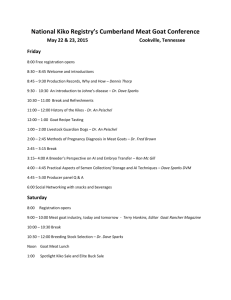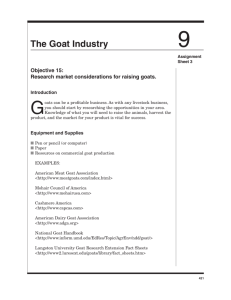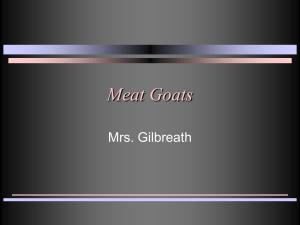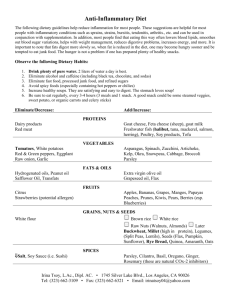No Goat Left Behind - Heritage Foods USA
advertisement
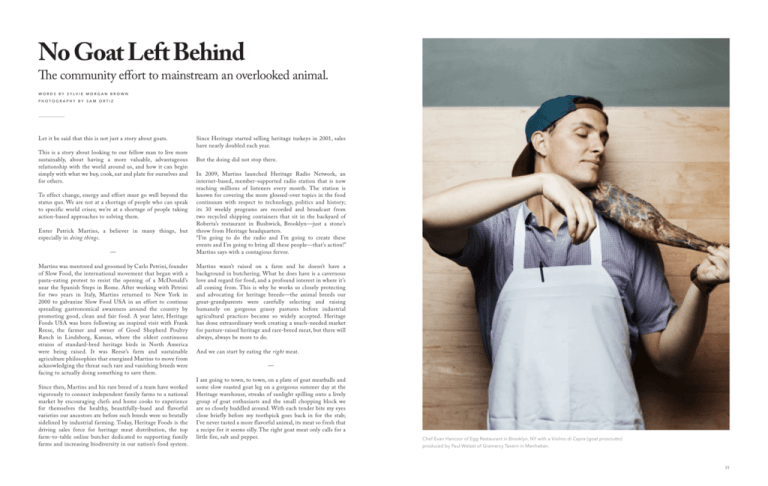
No Goat Left Behind The community effort to mainstream an overlooked animal. W O R D S B Y S y l v i e M or g a n B row n P H O T O G R A P H Y B Y S a m O rt i z Let it be said that this is not just a story about goats. This is a story about looking to our fellow man to live more sustainably, about having a more valuable, advantageous relationship with the world around us, and how it can begin simply with what we buy, cook, eat and plate for ourselves and for others. To effect change, energy and effort must go well beyond the status quo. We are not at a shortage of people who can speak to specific world crises; we’re at a shortage of people taking action-based approaches to solving them. Enter Patrick Martins, a believer in many things, but especially in doing things. — Martins was mentored and groomed by Carlo Petrini, founder of Slow Food, the international movement that began with a pasta-eating protest to resist the opening of a McDonald’s near the Spanish Steps in Rome. After working with Petrini for two years in Italy, Martins returned to New York in 2000 to galvanize Slow Food USA in an effort to continue spreading gastronomical awareness around the country by promoting good, clean and fair food. A year later, Heritage Foods USA was born following an inspired visit with Frank Reese, the farmer and owner of Good Shepherd Poultry Ranch in Lindsborg, Kansas, where the oldest continuous strains of standard-bred heritage birds in North America were being raised. It was Reese’s farm and sustainable agriculture philosophies that energized Martins to move from acknowledging the threat such rare and vanishing breeds were facing to actually doing something to save them. Since then, Martins and his rare breed of a team have worked vigorously to connect independent family farms to a national market by encouraging chefs and home cooks to experience for themselves the healthy, beautifully-hued and flavorful varieties our ancestors ate before such breeds were so brutally sidelined by industrial farming. Today, Heritage Foods is the driving sales force for heritage meat distribution, the top farm-to-table online butcher dedicated to supporting family farms and increasing biodiversity in our nation’s food system. Since Heritage started selling heritage turkeys in 2001, sales have nearly doubled each year. But the doing did not stop there. In 2009, Martins launched Heritage Radio Network, an internet-based, member-supported radio station that is now reaching millions of listeners every month. The station is known for covering the more glossed-over topics in the food continuum with respect to technology, politics and history; its 30 weekly programs are recorded and broadcast from two recycled shipping containers that sit in the backyard of Roberta’s restaurant in Bushwick, Brooklyn––just a stone’s throw from Heritage headquarters. “I’m going to do the radio and I’m going to create these events and I’m going to bring all these people––that’s action!” Martins says with a contagious fervor. Martins wasn’t raised on a farm and he doesn’t have a background in butchering. What he does have is a cavernous love and regard for food, and a profound interest in where it’s all coming from. This is why he works so closely protecting and advocating for heritage breeds—the animal breeds our great-grandparents were carefully selecting and raising humanely on gorgeous grassy pastures before industrial agricultural practices became so widely accepted. Heritage has done extraordinary work creating a much-needed market for pasture-raised heritage and rare-breed meat, but there will always, always be more to do. And we can start by eating the right meat. — I am going to town, to town, on a plate of goat meatballs and some slow roasted goat leg on a gorgeous summer day at the Heritage warehouse, streaks of sunlight spilling onto a lively group of goat enthusiasts and the small chopping block we are so closely huddled around. With each tender bite my eyes close briefly before my toothpick goes back in for the stab; I’ve never tasted a more flavorful animal, its meat so fresh that a recipe for it seems silly. The right goat meat only calls for a little fire, salt and pepper. Chef Evan Hanczor of Egg Restaurant in Brooklyn, NY with a Violino di Capra (goat prosciutto) produced by Paul Wetzel of Gramercy Tavern in Manhattan. 77 Patrick Martins, Founder of Heritage Foods “This leg is exquisite,” says Martins. “Think about how healthy that animal is, that you have to chew its meat like that.” Goat is the most widely consumed meat in the world, and yet here in the United States we’re either dismissing it without further thought, or just not seeing it anywhere for purchase. Meanwhile, from picnic tables to fine dining menus across the country, the demand for goat cheese just keeps growing. If you’re overlooking the relationship between the two, this one question will pave the way: how do you make cheese? Well, you need milk. To make milk, animals on the farm need to make babies, and they need to be doing it consistently. When goats have babies, they usually have twins or triplets, and when it comes to goat cheese dairies, it’s the birth of that male goat that is putting farmers in a tough position. Who can they market these goats to if American diners aren’t eating, or at the very least being offered the meat? Behind was started in 2011, “to address the growing problem facing New England goat dairies and has since developed into a celebration of all goat breeds, including meat breeds, with the goal of increasing overall goat consumption in America.” So rather than farmers selling the animals into the commodity market at a few days old, or even killing them at birth, Heritage partners with these dairies to purchase their surplus kids when they’re ready for harvest come autumn and sells them to over 70 New York City chefs who commit to featuring goat on their menus in a variety of delicious ways. This annual program reaches its crowning moment in October, or Goatober, a month-long menu event that works to introduce the meat to interested diners while also providing farmers with a viable end market for their male goats. Like many great ideas, the genesis for No Goat Left Behind began with a conversation around the dinner table between Martins and his wife Anne Saxelby, a renowned cheesemonger here in New York. “What’s happening to all those male goats if you can’t milk them?” she wondered. Catherine Greeley, head of mail order at Heritage, says that, “40 percent of what gets brought in from the farms is packaged individually with ice packs and sent out to people who are eager to start cooking with goat.” The mail order business at Heritage is really what drives Goatober and, “for us, it’s a consistently interesting challenge trying to best educate and explain to customers that we’re not only sustainable, we’re not only trying to support farms, but that we’re also trying to keep these goats alive that would otherwise be completely pushed out,” says Greeley. According to the Heritage Foods website, No Goat Left When I was first assigned this story, I had to think hard if I’d ever tasted goat. Maybe once in a taco? It seems most of us have only had this grass-fed, sustainable, otherwise-wasted meat once or twice, perhaps at an ethnic restaurant during a bout of bravery, or sadly––never at all. Immigrant populations and faith-based consumers in the United States who are more accustomed to eating goat have increased more than 100-percent during the last decade, and an appetite for the return of authenticity and novel, quality flavors are on the rise. Not to mention that goat meat is lean, nutritious and a readily available source of protein that makes all the environmental and dietary sense in the world. So why is it still so difficult to get people to eat it? I ask my mother one day if she has ever eaten goat. “Oh, no, I don’t eat goat,” she is quick to answer, her face scrunched as if smelling something rotten. “But you’ve tasted it?” “No, I just know it’s not for me.” — “I think with goat, people hear, ‘Oh, it’s super funky and it’s super gamey, and they have all these preconceived notions of what it is, and they think they’re turned off by it, but when it’s prepared properly––it’s beautifully rich, it’s slightly greasy but in a good way, and it’s got this subtle grassy flavor,” says Phillip Gilmour, chef and owner of Momo Sushi Shack, a Japanese tapas and sushi restaurant that adds goat gyoza to their menu during Goatober. “I’m Scottish on both sides of my family, which means I’m kind of obsessed with haggis. I’d already been playing around with the idea of doing some form of Japanese haggis, so I came up with the idea of doing gyoza using all the leftover goat parts––the head, the tongue, the liver, the kidneys. The initial one we did for Goatober had a mix of dates, almonds, garlic, rosemary, parsley and ras-elhanout, this moroccan lamb spice. They were a big hit with customers, so we do them a couple times a month now when we get the whole animal in.” Goat has also piqued taste buds over at Egg, a crowd-pleasing brunch restaurant in Williamsburg, Brooklyn, where Chef Evan Hanczor can be found butchering at least one goat a week during Goatober. “Actually, a lot of what we do at Egg are pork-based dishes, so to offer a non-pork option is interesting for people who want to try the goat, but also for the people who don’t eat pork,” says Hanczor, referring specifically to the restaurant’s popular goatchetta, a delicious take on porchetta where the goat loin gets wrapped in belly. “If you get creative with it, there are plenty of ways to use goat with breakfast even though it might not be the first thing that 79 “Goatchetta” comes to mind.” Incorporating the meat into his breakfast menu has been no trouble at all, he says, especially when you’re a proponent of using off-cuts, a surefire way to drive business up for the farmer. The classic southern country dish, “country captain,” “which is kind of like a curry chicken stew that has pork in it,” says Hanczor, “is done with off-cuts of the goat like shoulder bits, a part of the animal that wouldn’t normally see many other uses. It’s been a really popular dish for us.” On the flip side, over the bridge at high-end Del Posto, New York’s four-star Italian restaurant from the Mario Batali-Joe Bastianich restaurant group, the double belly ravioli featuring two distinctive braised goat shoulder fillings just wasn’t mainstream enough to compete with the beef rib-eye, the lamb chop or the chicken breast. “Goat has more of a chance at a restaurant that attracts more foodies, people who are into trying something new,” says Chef Matt Abdoo who, alongside Executive Chef Mark Ladner, couldn’t have been more excited to prepare a goat dish for Goatober a few years ago. But the two just couldn’t push enough goat past the kitchen to continue participating in the event. Even still, Abdoo remains optimistic about the future of goat consumption. Goat Country Captain “The people who are really into food––the people who ordered our ravioli––they loved it, absolutely loved it. It’s a beautiful, flavorful animal, and it’s really only a matter of time before goat has its chance to shine. And it’s soon, it’s definitely soon,” he says with conviction. “People know so much more about food now than they did 10 years ago–– like ridiculously more. And with the addition of the Food Network, the Cooking Channel, all the celebrity chefs, this strong movement of people really wanting to make chefing a career, and localities, and antibiotics this, and GMO that–– people are really wanting to know more and more about their food every day.” Despite the subpar reception at Del Posto, the appetite for goat is growing, and as diners continue to check their preconceived notion of what this “other” meat will taste like at the door, partnering farmers with No Goat Left Behind are definitely sleeping better knowing they have a dependable end market for their billies. “We’re seeing an increased acceptance of goat as a dining option, and that’s raised the demand for our Alpine bucklings,” says Michael Lee, owner of Twig Farm in West Cornwall, Vermont. He and and his wife, Emily, have been selling 10 to 12 goats to Heritage every October since the program’s inception. “We no longer have a difficult time caring for them, and come spring, we can hang on to as many of them as we’d like. Our relationship with Heritage has definitely helped us.” Before 2011, Mark Baustian and Luce Guanzini of Highwood Farm in Spencer, New York, had been holding onto their goats longer than they would have liked. “It was always dicey having to call around to everyone we knew trying to find someone to take them,” recalls Guanzini. “Heritage has been an excellent, secure market for us. They’re reliable, they pay a fair price per pound, and they use a slaughterhouse where the goats are handled humanely.” “Our entire business is done with a handshake,” Martins tell me. “Contracts mean nothing. No one’s going to sue anyone and go out to some farm and try to confiscate the last Red Wattle pigs in the country. That’s all corporate people and lawyers who tell you that a contract is necessary. But when you’re talking about craft and artisanship and talent and skills and knowledge, those rules don’t apply. It’s about quality. It’s about nuance.” “The food world is super small; all you really have in the end is your reputation and I think, for us, we work really hard to do right by everyone we work with and to keep lines of communication and transparency super open and super clear, especially when you’re trying to bring a new product in,” says Erin Fairbanks, the project coordinator of No Goat Left Behind. “We don’t operate in a space where we have the luxury of burning bridges, nor is it part of our ethos or anything we would have any interest in.” — Every year we grow, kill and eat more than 10 billion animals, the majority sold to us by too-large businesses choosing to conquer rather than cooperate with the living world around them. This meat has been directly impacting public health, the environment and our rural communities for decades. It’s time we embraced the idea of eating less meat, but spending much more for it and making a much bigger deal about the fact that we’re eating it. “What better way to fix all the social ills of the meat world, all that is lobbied and thrown against eating meat, than to take that energy and funnel it into something constructive?” asks Martins. “And rather than say, ‘Don’t eat meat,’ you have to actively dive into these projects and say, ‘I got a whole goat and it’s coming in three months!’ I mean, to me, that’s exciting. Because then your kids get it, and it comes in the box, and they’re like, ‘What’s this, dad?’ And you’re like, ‘That’s the shank, we’re gonna braise that, it’s gonna take forever. And see this? We’re gonna cure this one in our closet.’ That’s the best. That’s for show-and-tell.” For more information about Heritage Foods USA and No Goat Left Behind, or to have goat shipped directly to your home, visit www.HeritageFoodsUSA.com. 81
